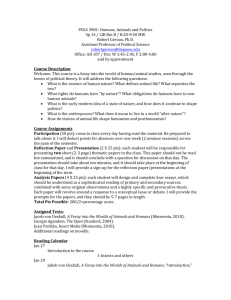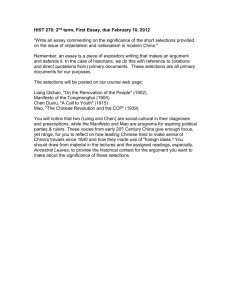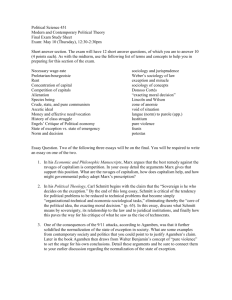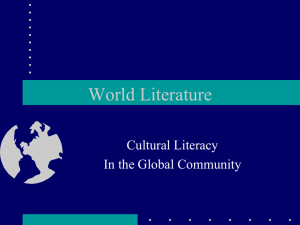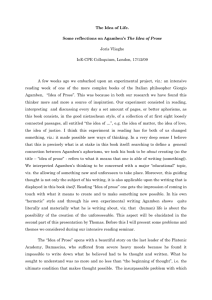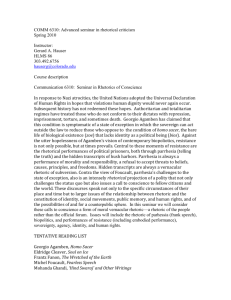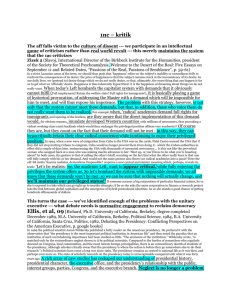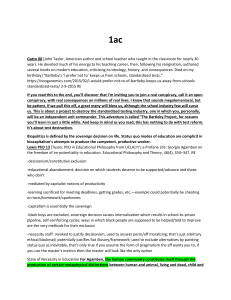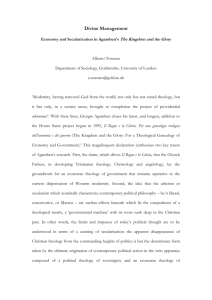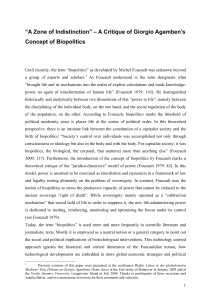Pols 390B Human and Animal Geroux
advertisement
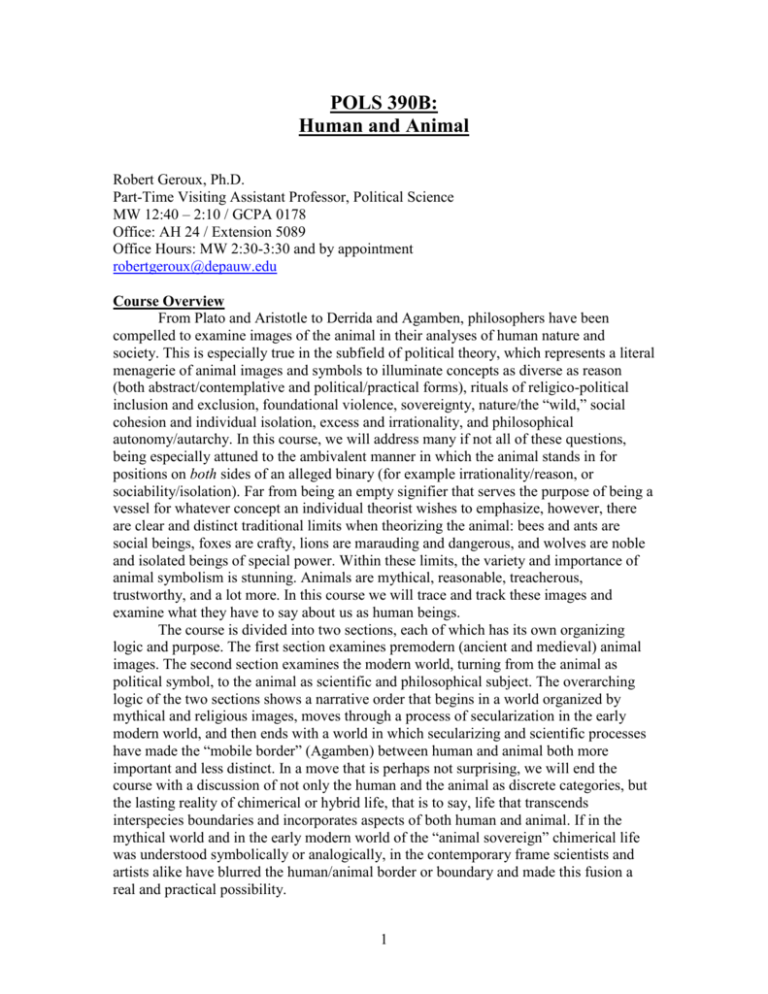
POLS 390B: Human and Animal Robert Geroux, Ph.D. Part-Time Visiting Assistant Professor, Political Science MW 12:40 – 2:10 / GCPA 0178 Office: AH 24 / Extension 5089 Office Hours: MW 2:30-3:30 and by appointment robertgeroux@depauw.edu Course Overview From Plato and Aristotle to Derrida and Agamben, philosophers have been compelled to examine images of the animal in their analyses of human nature and society. This is especially true in the subfield of political theory, which represents a literal menagerie of animal images and symbols to illuminate concepts as diverse as reason (both abstract/contemplative and political/practical forms), rituals of religico-political inclusion and exclusion, foundational violence, sovereignty, nature/the “wild,” social cohesion and individual isolation, excess and irrationality, and philosophical autonomy/autarchy. In this course, we will address many if not all of these questions, being especially attuned to the ambivalent manner in which the animal stands in for positions on both sides of an alleged binary (for example irrationality/reason, or sociability/isolation). Far from being an empty signifier that serves the purpose of being a vessel for whatever concept an individual theorist wishes to emphasize, however, there are clear and distinct traditional limits when theorizing the animal: bees and ants are social beings, foxes are crafty, lions are marauding and dangerous, and wolves are noble and isolated beings of special power. Within these limits, the variety and importance of animal symbolism is stunning. Animals are mythical, reasonable, treacherous, trustworthy, and a lot more. In this course we will trace and track these images and examine what they have to say about us as human beings. The course is divided into two sections, each of which has its own organizing logic and purpose. The first section examines premodern (ancient and medieval) animal images. The second section examines the modern world, turning from the animal as political symbol, to the animal as scientific and philosophical subject. The overarching logic of the two sections shows a narrative order that begins in a world organized by mythical and religious images, moves through a process of secularization in the early modern world, and then ends with a world in which secularizing and scientific processes have made the “mobile border” (Agamben) between human and animal both more important and less distinct. In a move that is perhaps not surprising, we will end the course with a discussion of not only the human and the animal as discrete categories, but the lasting reality of chimerical or hybrid life, that is to say, life that transcends interspecies boundaries and incorporates aspects of both human and animal. If in the mythical world and in the early modern world of the “animal sovereign” chimerical life was understood symbolically or analogically, in the contemporary frame scientists and artists alike have blurred the human/animal border or boundary and made this fusion a real and practical possibility. 1 Academic Integrity Violations of DePauw University’s Academic Integrity Policy will be taken very seriously. The complete Academic Integrity Policy can be found at: http://www.depauw.edu/univ/handbooks/dpuhandbooks.asp?ID=101&parentid=100 Assigned Texts Plato, Laches. Montaigne, Essays. Jakob von Uexkull, A Foray into the World of Animals. Giorgio Agamben, The Open: Man and Animal. Additional readings on reserve and TBA. Course Requirements and Assignments Participation (50 pts): come to class every day having read the material. Be prepared to talk about it. Reflection Paper and Presentation (50 pts): each student will be responsible for presenting one short thematic paper to the class. This paper should not be read but summarized, and it should conclude with a question for discussion on that day. The presentation should take about ten minutes, and it should take place at the beginning of class for that day. I will provide a sign-up for the reflection paper/presentations at the beginning of the term. Analysis Papers (4 X 25 pts each): each student will design and complete four essays, which should be understood as a sophisticated reading of primary and secondary sources, combined with some original observations and a highly specific and provocative thesis. Each paper will revolve around a response to a conceptual issue or debate. I will provide the prompts for the papers, and they should be 5-7 pages in length. Total Pts Possible: 200/2=percentage score. Reading Calendar 8.24-9.07 Introduction to the course The tradition of “Thereophily” in the West: origins Plato, Laches. Plutarch, “Beasts are Rational.” 9.07-9.14 Religion, philosophy, and animals Agamben, The Open, Chapters 1-9. Porphyry, On Abstinence From Killing Animals, selections. Paper One due 9.19 9.19-9.26 Thereophily in early modernity J.-B. Gelli, Circe. Montaigne, Essays, selections. 2 9.28-10.12 Wolves/Werewolves Saint Francis of Assisi, The Wolf of Gubbio. Giorgio Agamben, “The Wolf and the Ban,” Chapter Six of Homo Sacer. Film TBA. Paper Two due 10.12 Fall Break: 10.15-10.23 10.24-10.31 Animal Encounters I Agamben, The Open, Chapters 10-17. Jakob von Uexkull, A Foray into the Worlds of Animals and Humans (University of Minnesota Press), selections. We begin the contemporary section with Uexkull’s work (recently translated), which is foundationally important for attempting to understand the subjective or perspectival aspect of animal consciousness. 10.31-11.07 Donna Haraway, When Species Meet (University of Minnesota Press), selections. Paper Three due 11.07 11.09-11.21 Animal Encounters II Film: Grizzly Man, dir. Werner Herzog. o Herzog’s movie offers a disturbing reminder of the danger represented by the encounter between humans and animals. George Bataille, Theory of Religion, selections. Susan McHugh, “The Fictions and Futures of Farm Animals,” Chapter 4 of Animal Stories (University of Minnesota Press). 11.23-11.27 Thanksgiving Recess 11.28-12.07 Hybridity and Chimeras Jacques Derrida, The Animal That Therefore I Am (Fordham University Press), selections. Film, TBA. Paper Four due 12.07 3
